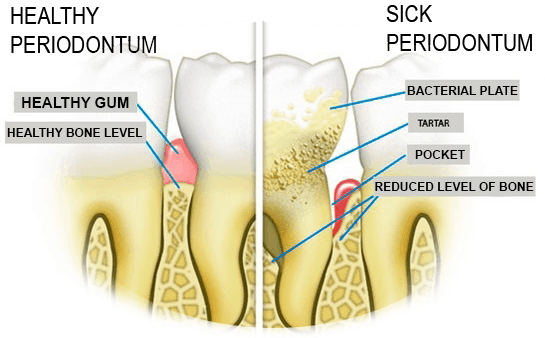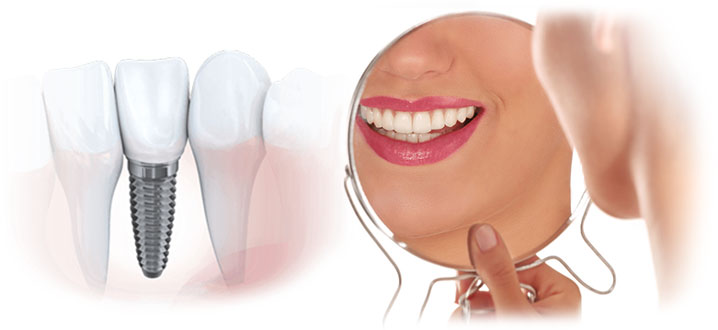Periodontology
Periodontology
This branch of dentistry treats problems of the periodontium (also called periodontal or periodontal tissue), the hard and soft structures that support the teeth: gums, alveolar bone, periodontal ligament and root cement. All these elements work together to keep the teeth in the jaws fixed and stable during chewing.
Periodontology therefore deals with the diagnosis, the medical treatment and also the prevention of periodontal diseases. During the dental examination, the specialist examines your gums, checks if a gum recession has occurred, and checks with a probe the periodontal spaces, the spaces between tooth and gum.
Periodontal diseases
Among the diseases treated by periodontology, periodontitis is certainly the most serious and dangerous disease because it can easily progress over time and it cause serious problems that can lead to tooth loss and to systemic pathologies. This happens because the infection attacks the bone that supports the teeth.
The development of this disease is caused by the proliferation of bacteria inside the mouth due to a poor oral hygiene, which may initially cause the inflammation of gums (gingivitis) which, if not treated in time, may involve the underlying tissues, giving rise to periodontitis.
The disease can also be caused by an excess of tartar, dental procedures not performed correctly or other pathologies such as smoking, diabetes, vitamin C deficiencies, etc.
From numerous scientific researches it has emerged recently that periodontitis can also be due to hereditary factors, especially in its more aggressive forms.
Unfortunately this disease, despite its severity, tends to manifest itself with mild symptoms that make people not realize they have it.
The first symptoms of periodontal disease are:
Gingivitis:
Periodontitis:

Periodontology: Gingivitis
This disease, the mildest of periodontal diseases, manifests itself with a reddening of the margins of the gingiva, swelling and even bleeding during the rubbing of the toothbrush. It can occur in chronic or acute form: in the first case it is due to the plaque that covers teeth and gums, in the second case has as specific infections or traumas.
Gingivitis can be prevented by careful and daily oral hygiene, using a brush and floss.
The causes of gingivitis, besides the poor oral hygiene, are due to smoking, diabetes, a genetic predisposition, aging, drug abuse, some medicines, HIV infection, but also pregnancy and puberty can lead to gingivitis.
Periodontology: Periodontitis
It is the periodontal disease that affects the alveolar bone and the periodontal ligament. It is a practically a painless disease: when gingivitis progresses in periodontitis, there is no pain, the only symptom of the disease is the teeth loosening.
Neglected gingivitis can lead to periodontitis. The plaque, not removed, it increases infiltrating under the gum. The toxins produced by the bacteria it irritates the gums and creates an inflammation that undermines the tissues that support the teeth. It will be formed some periodontal pockets and will infect, deepening and destroying the gum tissues. The teeth may loosen and must be removed.
Go back to smiling and chewing your favorite foods in complete safety
Symptoms of periodontal diseases
- Bleeding gums during the use of toothbrush
- Redness and swelling of the gums
- Heavy halitosis
- Deep pockets formation between teeth and gums
- Teeth loosening
- Pain during chewing
- Plaques and / or pus on the gums
Treatment and therapy of periodontal diseases
The treatments for gingivitis and periodontitis depend on the stage of the diseases. In the case of a gingivitis at the initial stage it will be necessary only to remove the plaque and to ensure a daily and accurate oral hygiene.
Action is taken with specific non-surgical therapies to control bacterial growth and with surgical therapies to restore the tissue that supports the teeth.
Periodontal surgery treatments for gum disease
- Reduction of periodontal pockets: the tartar is removed by lifting the gums and then repositioning them adherent to the teeth.
- Bone grafting: fragments of your own bone, synthetic bones or donated bones are used to replace the destroyed bone. The graft will allow the bone growth.
- Soft tissue grafts: it serves to reinforce the gums with a grafted tissue, taken from the mouth.
- Guided tissue regeneration: stimulates the growth of the gum and the bone tissue. A tissue is inserted between the bone and the gum allowing the bone and gum tissue to grow back.
- Bone surgery: it serves in the case of a moderate or an advanced bone loss. The bone around the tooth is reshaped to prevent the growth of bacteria.








